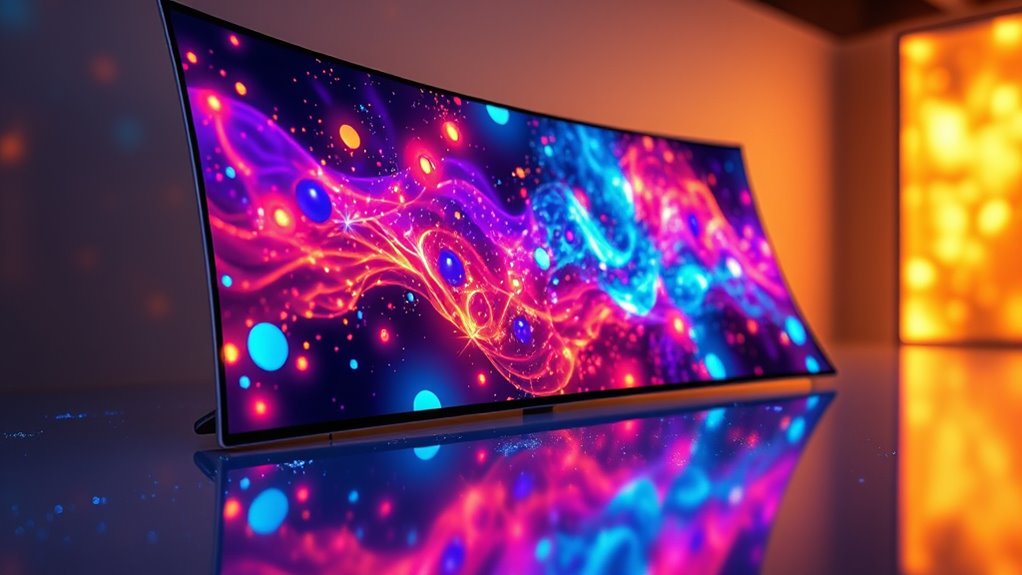Your collectible might change overnight because dynamic NFTs update their metadata in real time based on external data, user actions, or events. Unlike static NFTs, which stay fixed after minting, these NFTs can evolve to reflect new information or achievements automatically. Blockchain guarantees these updates are secure and transparent. If you want to see how these changes happen and what makes them so exciting, there’s more to explore on this fascinating technology.
Key Takeaways
- Dynamic NFTs can update their metadata automatically based on external data or triggers.
- Blockchain technology ensures all changes are secure, transparent, and tamper-proof.
- Smart contracts facilitate real-time updates driven by events, time, or user interactions.
- External data feeds enable NFTs to reflect live information, causing changes overnight.
- Customization and automation make your collectible evolve without manual intervention.

Have you ever wondered how NFTs can evolve beyond static digital assets? Traditional NFTs serve as digital certificates of ownership for images, music, or videos, but they often remain unchanged once minted. Dynamic NFTs, however, break this mold by enabling your collectibles to change over time. This transformation is made possible through the clever use of NFT metadata and blockchain integration. NFT metadata holds all the essential information about your digital asset, such as its appearance, attributes, or associated data. Unlike static NFTs, where metadata is fixed, dynamic NFTs allow this data to be updated, leading to real-time changes in how your collectible looks or behaves. For example, a digital artwork might evolve to reflect current events or personal milestones, making your collection more interactive and engaging.
Blockchain integration plays an indispensable role in making these updates secure and transparent. When your NFT’s metadata is altered, the changes are recorded on the blockchain, ensuring that every modification is traceable and tamper-proof. This means you can verify that your NFT has genuinely changed and that the updates are authorized. Smart contracts act as the backbone here, automating the process of updating metadata based on external data feeds or specific triggers. For instance, a gaming NFT could change its appearance based on your in-game achievements, all automatically updated through connected data sources. This seamless integration guarantees that your dynamic NFT remains authentic and trustworthy, even as it evolves.
The ability to modify NFT metadata in real-time opens up a world of possibilities for collectors and creators. Imagine owning a digital pet that grows and ages, or a sports card that updates with the latest stats and highlights. These changes foster a deeper connection between you and your digital assets, transforming passive ownership into an interactive experience. You can even set conditions for updates, such as time-based changes, external events, or user interactions, making each NFT uniquely personalized. Additionally, privacy and cookie regulations play a crucial role in ensuring that your digital interactions are secure and compliant, especially when third-party data sources are involved. All of this hinges on robust blockchain integration that maintains the integrity and security of every update.
In essence, dynamic NFTs redefine what it means to own and collect digital assets. By leveraging flexible NFT metadata and blockchain integration, your collectibles can change overnight, making them more lively, meaningful, and fun. This innovative approach ensures that your digital assets aren’t just static images but evolving pieces of art and data, perfectly suited for the digital age.
Frequently Asked Questions
Can Dynamic NFTS Increase in Value Over Time?
Yes, dynamic NFTs can increase in value over time. Their NFT evolution allows them to adapt and change, which can boost their appeal and rarity. As collectors see the value fluctuation based on the NFT’s unique features or updates, demand may grow, driving up prices. You might find that these evolving collectibles become more desirable as their stories or attributes develop, making them potentially more valuable in the future.
Are Dynamic NFTS More Vulnerable to Hacking?
You might wonder if dynamic NFTs are more vulnerable to hacking. They can be, since smart contract vulnerabilities could be exploited or compromised. Also, if user authentication isn’t strong, hackers could gain access and manipulate your NFT’s data. Always guarantee that the platform you use has robust security measures, including secure smart contracts and solid user authentication, to protect your dynamic NFT from potential threats.
How Do Creators Control NFT Updates?
You can regulate NFT updates through smart contract security measures that let creators set rules for changes. By deploying secure, well-audited contracts, creators maintain control over how and when their NFTs update. This ensures that only authorized modifications occur, protecting against vulnerabilities. With strong creator control and smart contract security, you can confidently manage your dynamic NFTs, keeping them secure while allowing meaningful updates that enhance value or interaction.
Can I Revert to a Previous NFT State?
You can often revert to a previous NFT state if the smart contract controls allow it. By accessing the NFT metadata, you might be able to restore earlier versions, but it depends on how the creator set up the smart contract controls. Not all NFTs are designed to be reversible, so check the specific smart contract details and metadata options to see if reverting is possible for your collectible.
Are Dynamic NFTS Compatible With All Blockchain Platforms?
You might wonder if dynamic NFTs work across all blockchain platforms. Not all blockchains support the same features, but many prioritize blockchain interoperability, allowing you to transfer and interact with NFTs across different networks. Smart contract flexibility also plays a role, enabling dynamic NFTs to adapt and change. So, while they’re not universally compatible, many platforms now incorporate these features, making it easier to use dynamic NFTs across various blockchains.
Conclusion
Dynamic NFTs are transforming the way you interact with collectibles, making them more than just static assets. With their ability to change overnight, your NFTs become personalized and engaging, offering new ways to showcase your digital assets. Embrace this innovative technology to keep your collection fresh and exciting. As the NFT landscape evolves, staying informed about dynamic features helps you make smarter, more dynamic choices in your digital journey.









